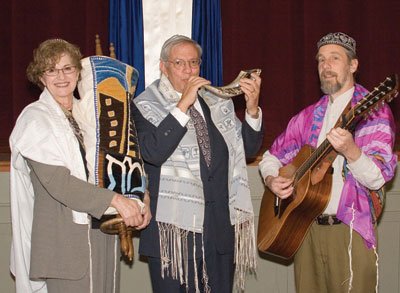Next week begins a 10-day period so sacred to Judaism that it is
often called the
”
High Holy Days.
”
This year, Rosh Hashanah begins on the evening of Sept. 12.
(Most Jewish holidays begin at dusk because the dates are set
according to an ancient lunar calendar.) After sundown on Sept. 12
begins the first day of the new year in the Jewish calendar; at
that time the date will become 5768.
Next week begins a 10-day period so sacred to Judaism that it is often called the “High Holy Days.”
This year, Rosh Hashanah begins on the evening of Sept. 12. (Most Jewish holidays begin at dusk because the dates are set according to an ancient lunar calendar.) After sundown on Sept. 12 begins the first day of the new year in the Jewish calendar; at that time the date will become 5768.
Joining with Jews around the world, members of South County’s Congregation Emeth will participate in ancient rituals that reflect the essence of being a Jew.
Nearly every year at this time I have written about the High Holy Days, usually discussing the many interesting traditional customs practiced during this important time period. This year, however, I depart from that approach to quote from some remarks of Debbie Israel, Acting Rabbi of Congregation Emeth.
Here she offers some reflections that us help to understand the true significance of this important occasion in the lives of Jews, going beyond the outer public ritual to the inner meaning.
The great theme of Rosh Hashanah is “change.” Jews use this time to analyze their lives, to see where they have “gotten off course (by hurting others) in their relationships with family, friends, and others and how they can improve themselves my making personal changes in the coming year.
“The process is called ‘cheshbon hanefesh,’ an accounting of the soul, by first examining behavior during the past year and then beginning the process of making restitution,” she explains.
“We are instructed to especially consider those people whom we have harmed or wronged and to go to them to ask for forgiveness.
“As we enter this sacred time, we should ask ourselves ‘How does God see us as compared to last year?’ If the answer is ‘not much different,’ it indicates one is in a spiritual rut.
“If you haven’t grown much in the past year, then what is the point of life?
“The High Holiday season is a time to make goals for the new year, to consider relationships with family, friends, and God,” Israel says.
“If there are relationships that need repair, it’s never too late to begin, and it’s never too late to finish.”
Yom Kippur’s theme, on the other hand, is forgiveness: “our forgiving others and being forgiven by others and God.
“The services of Yom Kippur are “a gift to us, opportunities that Judaism gives us to express forgiveness, reparation and the finishing of grace.”
“The High Holiday liturgy helps us to appreciate the wonderful people in our lives now, as well as those who once were part of our lives and now live under the protection of God’s sheltering arms in the World to Come.
“We hope this process of forgiving and being forgiven helps bring us to a place where we can forgive ourselves for the mistakes we make.
“The liturgy brings us to an understanding that only God is perfect, and all humans make mistakes. Just as God forgives, we must forgive ourselves.”













